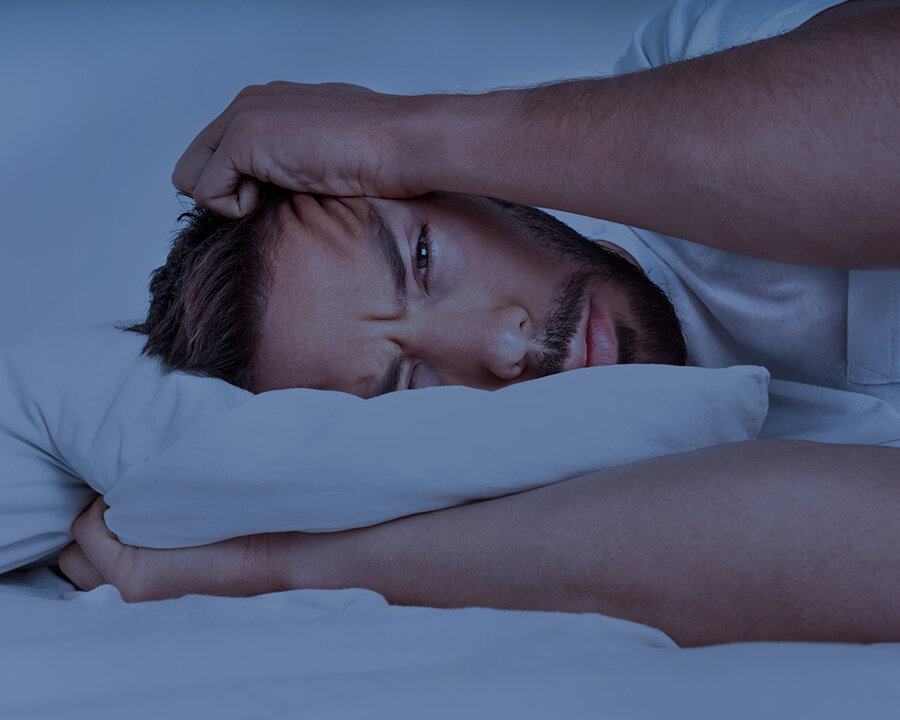Do you feel like you need help with sleep? Do you toss and turn during the night more than you would like?
Maybe you’re up pacing around the house for hours on end?
The benefits of good sleep extend far beyond you. Sleeping well makes you more productive, less prone to accidents, and generally happier. This ripple effect can impact families, communities, and society at large.
Unfortunately, sleep disorders like insomnia are on the rise in Australia, with many factors at play, from stress to underlying medical conditions. Yet, sometimes, even more subtle disruptions in the sleep cycle have a physical cause rather than a cognitive or environmental one. This is where the gentle hands and keen eyes of an osteopath may be the key to dropping off easier and getting better quality sleep.
Osteopathy can help with various conditions, from musculoskeletal conditions to preventative care, but it can also improve sleep issues.
 What Causes Sleep Problems?
What Causes Sleep Problems?
Before we look at how osteopathy could help improve your sleep, let’s dive into the science behind what helps and hinders sleep. Sleep is a complex process governed by three main mechanisms: the circadian rhythm, homeostasis, and allostatic load. The push and pull between sleep pressure (homeostasis) and the body’s readiness to sleep (circadian rhythm) are measurable, but they can be thrown off by pain, discomfort, or other forms of physical imbalance. For example, aches and pains are a leading cause of insomnia worldwide.
Insomnia isn’t just a rebellion of the mind against sleep. It’s a complex condition with many faces, affecting different people uniquely. It can manifest as difficulty falling, staying, or poor sleep quality, leading to profound impacts on daily functioning and health status. Medical professionals like to categorize insomnia into two types: primary and secondary. Primary insomnia occurs when sleep problems are not directly associated with other health conditions. In contrast, secondary insomnia is a symptom of a medical condition, medications, or other sleep disorders.
Other environmental and physiological triggers for poor sleep that can interrupt natural sleep cycles include:
- Stress: In our modern, high-paced world, the mind often struggles to quiet down, even when the body is weary. The release of stress hormones can keep the body in a state of high alert, making it nearly impossible for the mind to drift into peaceful sleep.
- Poor sleep hygiene: An irregular sleep schedule, sedentary living, and excessive screen time can all sabotage our circadian rhythm. In particular, the blue light on screens can disrupt your body’s natural production of melatonin, the hormone responsible for sleepiness. Sleep hygiene is a set of habits and evening rituals that promote quality sleep. It offers a blueprint for structuring your evening to ensure that sleep is a priority and that the environment is conducive to the pursuit of sleep.
- The wrong type of food/drink close to bedtime: Diet plays a more significant role in sleep than many people realise. The consumption of caffeine and alcohol, especially within a couple of hours of bedtime, can stop you falling asleep and staying asleep. Heavy meals before bed can also cause discomfort that disrupts the sleep cycle.
- High background light and noise levels: Creating a sleep-friendly environment is crucial to good sleep hygiene. This involves ensuring that your bedroom is cool, dark, and quiet. Use white noise machines or earplugs if you live in a noisy environment.
What Is Osteopathy?
In a world where medical practices are as varied as food menus and wellness trends are as fleeting as fashion fads, there’s a practice that has stood the test of time – osteopathy. Yet, for many people, the word “osteopathy” remains mysterious. So, what is this holistic approach to health?
If you ask a random person in the street what they think osteopathy is, you’ll likely be met with a response involving joint “cracks”, back pain, and a vague notion of it having something to do with chiropractic care. However, osteopathy is so much more. Osteopathy can be helpful for a wide range of health conditions and concerns. It is particularly known for its effectiveness in treating musculoskeletal issues, such as back pain, joint pain, and sports injuries.
However, the holistic approach can also be a valuable adjunct to conditions that might not seem directly related to the musculoskeletal system. By tackling the root causes of your pain and other problems, we aim to provide long-term relief and improved functionality.
At its core, osteopathy treats the whole person rather than just the symptoms. Its founder, Dr. Andrew Taylor Still, emphasized a belief in the body’s natural ability to heal itself if it’s in balance. This means that our work does not solely aim to correct misalignments or “crack” bones; we also help the body return to a natural state of equilibrium.
We use a range of manual treatment techniques, including:
- Soft Tissue Manipulation: Stretching and applying pressure to muscles, ligaments, and tendons to improve function.
- Articulation: Gentle oscillatory movements to enhance mobility.
- Visceral Manipulation: Techniques that improve the function of the internal organs.
- Cranial Osteopathy: A subtle yet powerful treatment addressing the head, spinal column, and sacrum bones.
As well as these manual therapies, we may also recommend specific exercise or diet modifications to support your health and recovery. In a modern healthcare landscape, where patients are sometimes data points in a system overloaded with specialization, osteopathy’s holistic approach is having a renaissance. The focus on treating the whole person, combined with a hands-on, patient-centric approach, is a more personalized and natural route to health.
It’s not an alternative to conventional medicine (where necessary) but a complement. If you’re undergoing treatment for conditions like asthma, migraines, or even digestive issues, you can benefit from osteopathy.
By combining treatments, you also reap the benefits of a more well-rounded treatment plan. So, if you’re looking to enhance your wellbeing, osteopathy treatment aligns with a more holistic (whole body) approach to health. It’s not a one-size-fits-all solution, but it offers a personalized approach that considers the many interconnected aspects of health, including emotional, physical and mental.
But whether you’re considering osteopathy to address a specific ailment or as a proactive measure to maintain health, it’s vital to approach the practice with an open mind. Osteopathic care requires commitment and active participation in your treatment, which can lead to a greater understanding and appreciation of your body’s capabilities and needs. But what attracts health-conscious people most to osteopathy is its non-invasive nature and emphasis on non-pharmacological treatments.
Our practice offers a unique and valuable perspective on health and healing. Focusing on you as an individual, treating your unique constitution, and restoring balance within your musculoskeletal system.
How Osteopathy Can Help With Sleep
In contrast to chiropractic practices, which typically use manual adjustments to the spine, osteopathic treatments extend to the entire body with a focus on balancing the musculoskeletal framework. This can address specific pain points and systemic tension, which may be contributing to sleep deprivation. While effective for certain ailments, chiropractic care can sometimes neglect the broader needs of the body, might not always help with sleep the way an osteopath can.
Osteopathic Manipulative Treatment (OMT) is our primary tool to help with sleep. It can include soft tissue techniques like myofascial release for muscle tension. Articulatory techniques to gently move joints through their natural range of motion to reduce aches and pains. And craniosacral therapy is a subtle form of bodywork that can influence the central nervous system and relax the body. Together, they can provide surprising results in encouraging deeper, more restful sleep.
But what sets osteopathic treatment apart in the context of sleep care is the individualized nature of our approach. While general tenets and principles exist, each patient’s path to better sleep is unique. We don’t just treat the symptoms of poor sleep; we work to understand the entire person. This means tailoring the treatment to address the specific postural, muscular, and emotional obstacles preventing “rest”.
We often see geriatric patients with chronic neck pain, which worsens with stress and leads to frequent waking throughout the night. However, with a series of osteopathic treatment sessions, these patients report alleviation of their neck pain but also a newfound ability to sleep through the night because the neck pain was both a physical and emotional stressor. Central to osteopathic philosophy is the body’s potential to heal itself.
By removing barriers to health, including physical restrictions, we empower your body to do what it naturally strives to — function at its best, including during the vital restorative period of sleep.
However, it’s essential to approach osteopathy with realistic expectations. While some may find immediate “overnight” relief and improved sleep, others may need longer for the benefits to be noticeable. Combining osteopathy sessions with other changes, such as sleep hygiene practices or addressing other health issues, may be necessary for comprehensive treatment.
Sleep medication and quick fixes often overshadow more natural approaches to good sleep. Still, osteopathy serves as a gentle, comprehensive alternative. Our treatment principles fit well with the subtle complexities of the sleep process, addressing the whole rather than the parts. But the assertion that osteopathy is a silver bullet for all sleep woes would be as misguided as overly optimistic.
However, osteopathy offers a different lens through which to view sleep issues and a methodology for addressing them that is both proven and profoundly patient-centric. If you’re an insomniac or restful sleeper, it could be the recalibration you have been seeking

